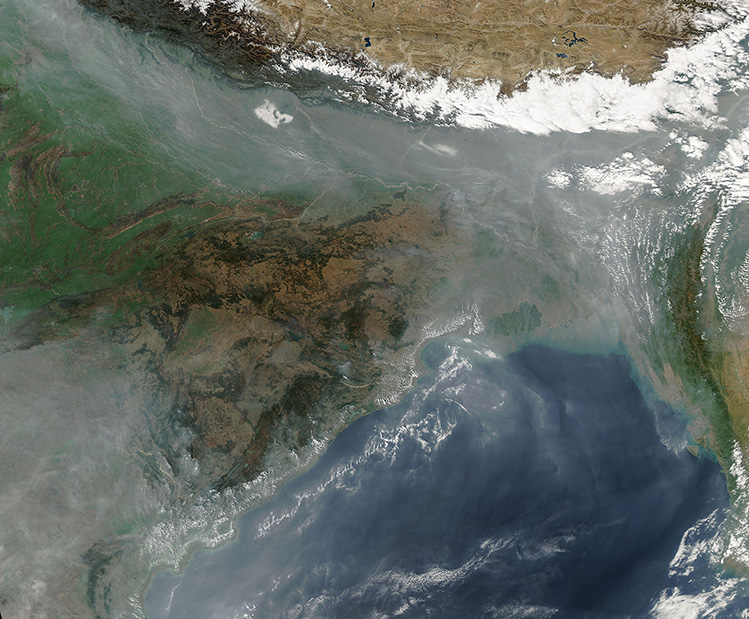Images
January 30, 2025 - Haze Lingers over India and Bangladesh
Tweet
Heavy gray haze blanketed much of India and Bangladesh on January 28, 2025, when the Moderate Resolution Imaging Spectroradiometer (MODIS) on NASA’s Aqua satellite acquired this true-color image. The haze accumulates so densely that much of the land south of the tall peaks of the Himalayas well as the low-lying topography of Bangladesh is shrouded from view.
The gray pall marks heavy accumulation of aerosols—fine solid and liquid particles—suspended in the atmosphere. The particles may absorb or scatter sunlight, depending on the various shapes and chemical makeup, but the cumulative result is an opaque gray tint to the skies. These particles, especially the smallest ones, are also dangerous for respiratory health of people and animals when they make their way into lungs.
The aerosols present in winter in this region come from many sources, including biomass burning for agriculture, coal-fired industry, coal use for warmth, automobile exhaust, and industrial processes. Some aerosols may be natural in origin, such as dust. Air inversions, when a warmer layer of air up high holds cooler air trapped close to the ground, are common in this region in winter and play an important role in creating lingering haze. Aqua MODIS imagery viewed on NASA Worldview shows that the most recent clear-air day over Bangladesh was December 16, 2024.
Image Facts
Satellite:
Aqua
Date Acquired: 1/28/2025
Resolutions:
1km (1.1 MB), 500m (1.8 MB), 250m ( B)
Bands Used: 1,4,3
Image Credit:
MODIS Land Rapid Response Team, NASA GSFC
Tweet
Heavy gray haze blanketed much of India and Bangladesh on January 28, 2025, when the Moderate Resolution Imaging Spectroradiometer (MODIS) on NASA’s Aqua satellite acquired this true-color image. The haze accumulates so densely that much of the land south of the tall peaks of the Himalayas well as the low-lying topography of Bangladesh is shrouded from view.
The gray pall marks heavy accumulation of aerosols—fine solid and liquid particles—suspended in the atmosphere. The particles may absorb or scatter sunlight, depending on the various shapes and chemical makeup, but the cumulative result is an opaque gray tint to the skies. These particles, especially the smallest ones, are also dangerous for respiratory health of people and animals when they make their way into lungs.
The aerosols present in winter in this region come from many sources, including biomass burning for agriculture, coal-fired industry, coal use for warmth, automobile exhaust, and industrial processes. Some aerosols may be natural in origin, such as dust. Air inversions, when a warmer layer of air up high holds cooler air trapped close to the ground, are common in this region in winter and play an important role in creating lingering haze. Aqua MODIS imagery viewed on NASA Worldview shows that the most recent clear-air day over Bangladesh was December 16, 2024.
Image Facts
Satellite:
Aqua
Date Acquired: 1/28/2025
Resolutions:
1km (1.1 MB), 500m (1.8 MB), 250m ( B)
Bands Used: 1,4,3
Image Credit:
MODIS Land Rapid Response Team, NASA GSFC




